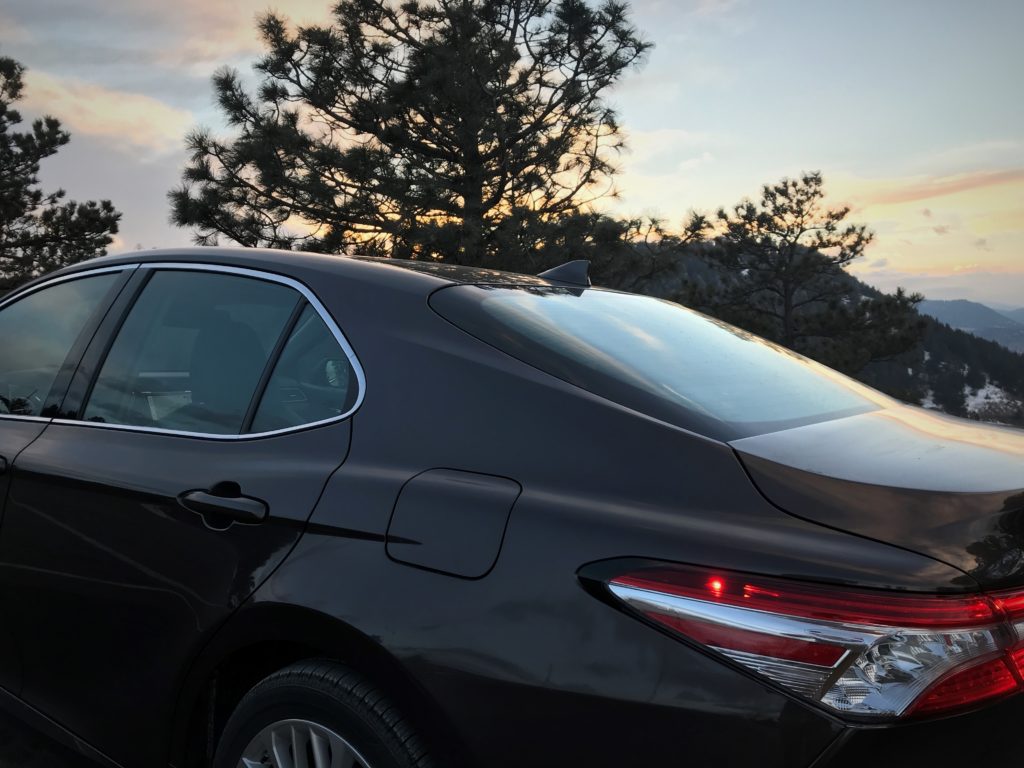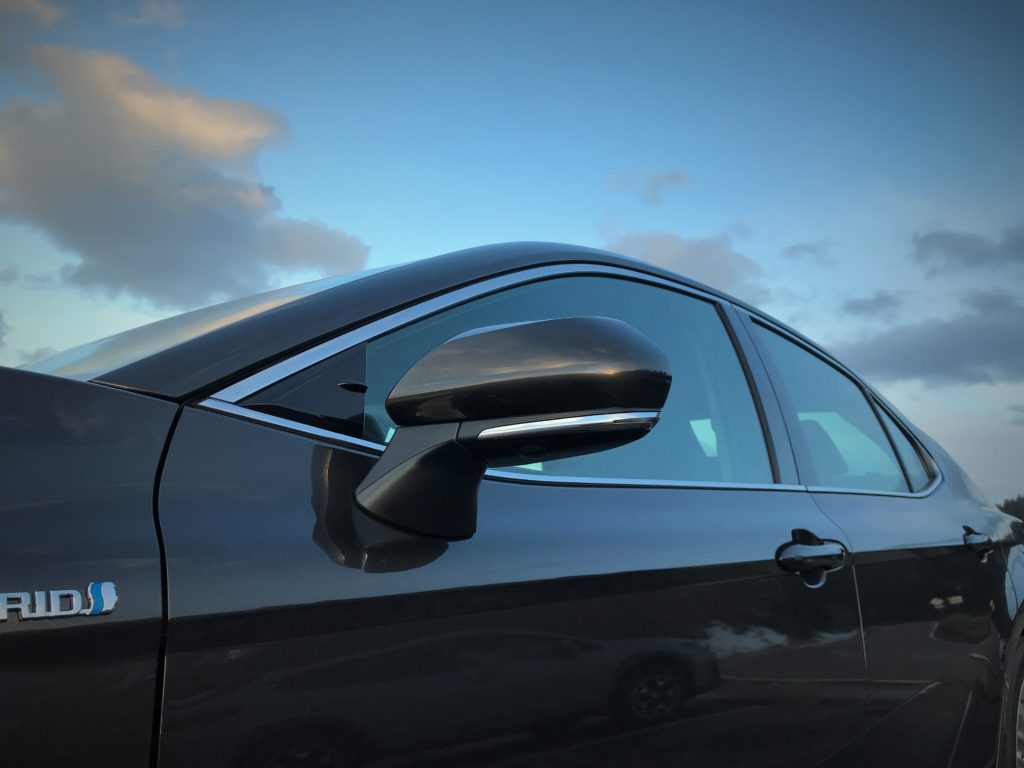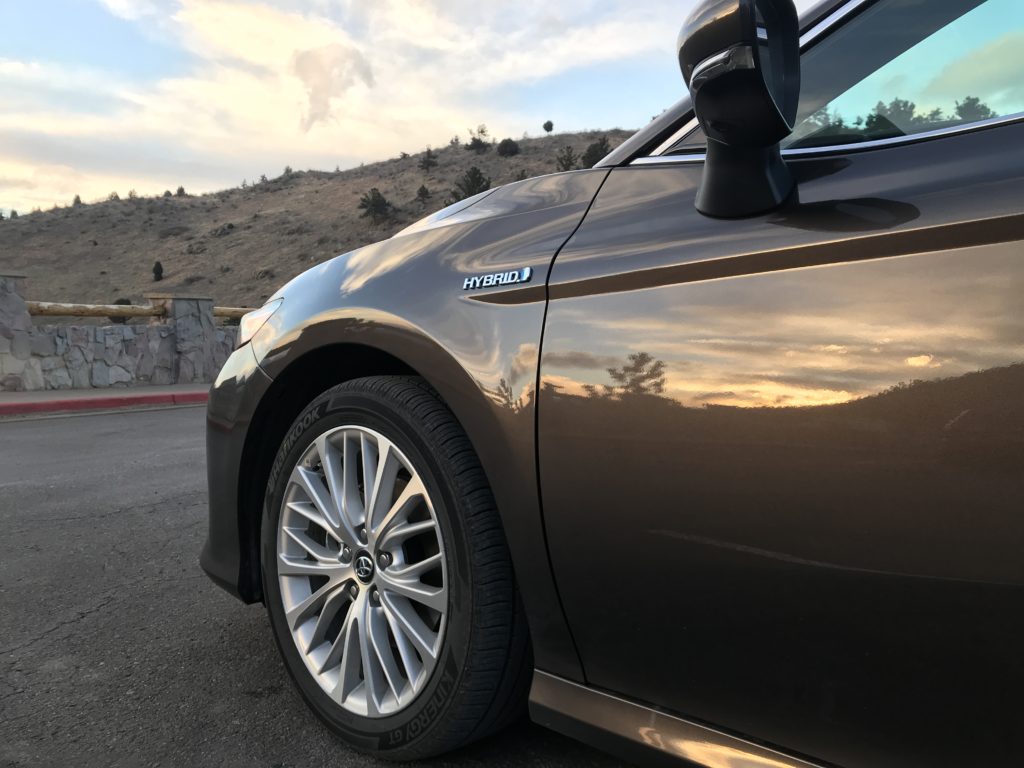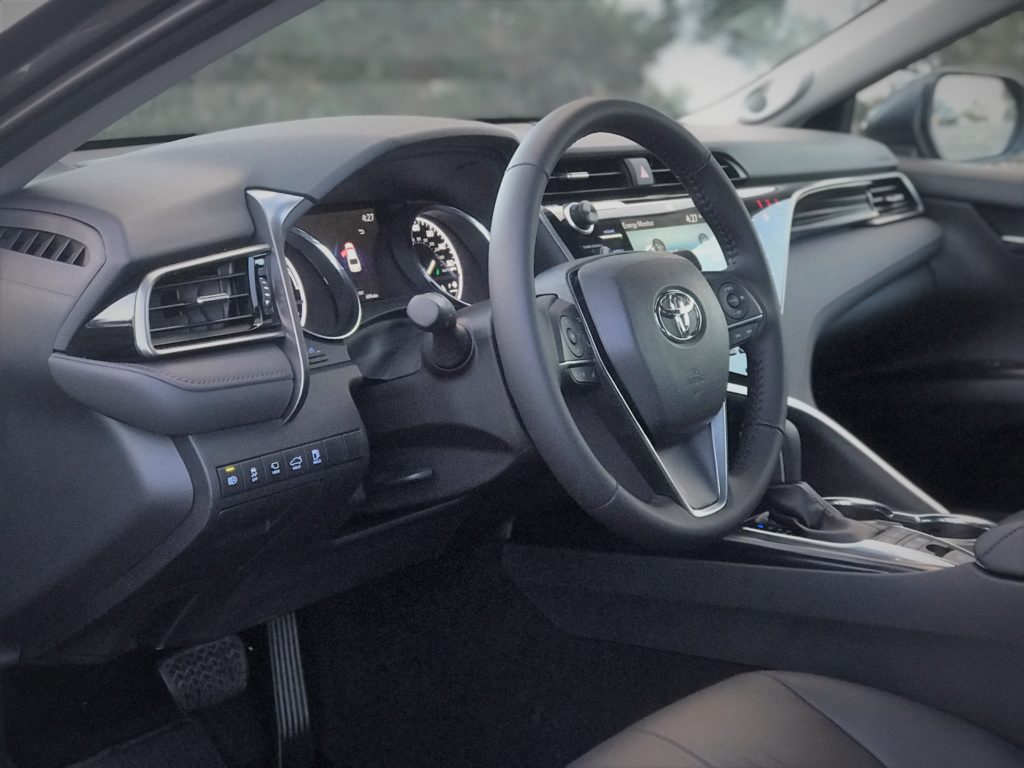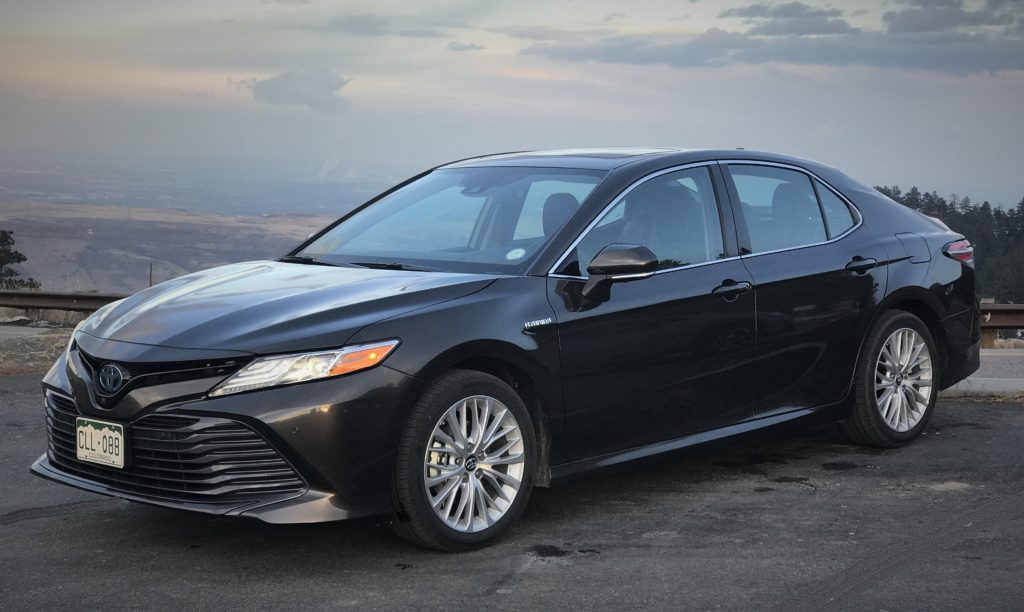The 2019 Toyota Camry Hybrid XLE brings all of the goodness of a completely new (for 2018) body structure and design theme. Looking to break out from the just-another-Camry mold, this latest generation sees increased refinement with higher quality interior materials and presents a sound case that this is the best Camry yet.
Pricing and Features
The days of a $40k Toyota Camry are near as this fully optioned model is $38,215 out the door. High tech features and luxurious details, plus the hybrid powertrain, maintain the sense of value that has always been a big part of the the Camry’s pedigree.
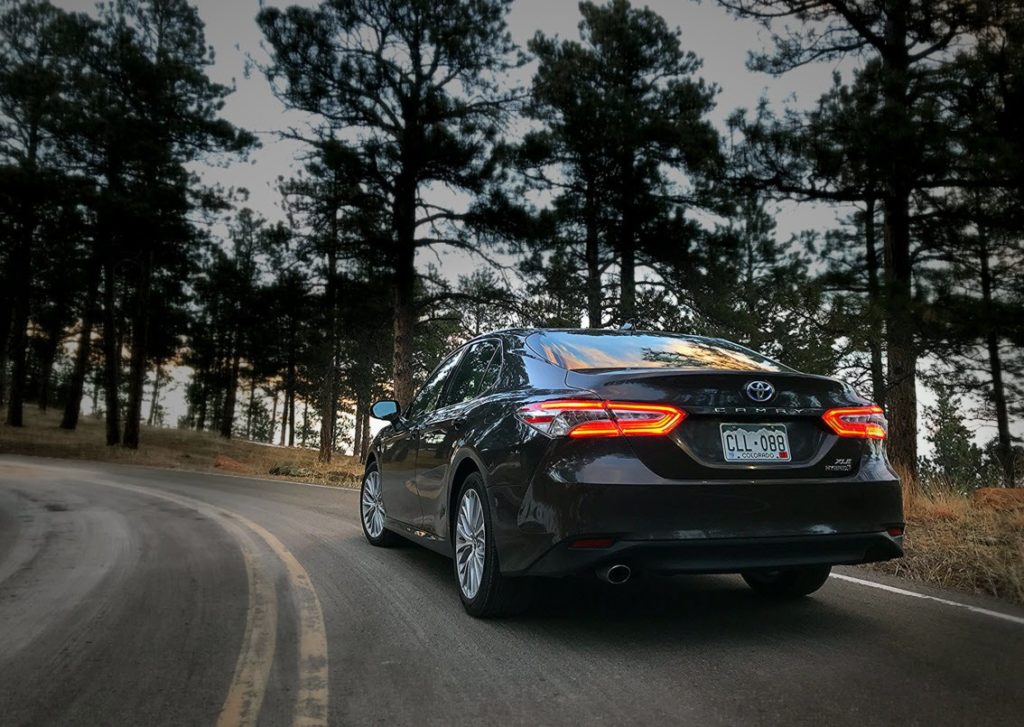
Full LED headlights with dynamic curve control, LED taillights, bright 18-inch wheels, a sunroof, and a polished exhaust tip out back provide a handsome and modern exterior look. Proximity entry opens the way to a soft leather interior with eight-way power front seats, though only the front seats are heated and ventilation is not an option. Another notable omission at this price is the lack of a heated steering wheel.

Once inside, the driver is greeted with two large analog gauges; a power meter, which swings dramatically between moments of power boost and battery recharging, and a speedometer. In between, a seven-inch digital display provides additional information and a head-up display (HUD) puts the information near the line of sight. Unfortunately, the displays’ layouts have a busy appearance with small icons that are scattered among large and styled graphics. Simply put, the Honda Accord’s display layouts are better at conveying information at a glance although more time with the Camry may negate this distraction.
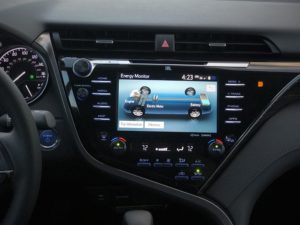
An eight-inch touchscreen resides in the center of the dash and enables control of Toyota’s Entune infotainment system. Compatible with Apple CarPlay, Sirius Satellite, and HD radio, the JBL Clari-Fi premium sound system is both clear and very capable. In fact, the nine-speaker 800-watt system seems almost too powerful as it can easily excite rattles in the b-pillar, door, and rear parcel shelf. Toyota includes several USB ports and a Qi-compatible wireless charging mat to ease the “range anxiety” of your phone. The navigation system is quick to respond and directions are additionally displayed in the dash and HUD. Certainly one of the car’s wow-features is a 360-degree bird’s-eye view system that provides a perimeter scan. Essentially a walk-around view of the exterior of the car, it may seem gimmicky at first, but it proved to be effective quickly verifying the car’s surroundings after parking and before pulling away.
For those who aren’t aiming to have every available feature or the hybrid powertrain, Toyota offers the gas-only LE trim with a cloth interior, blind spot monitoring, dual zone climate control, and proximity entry for about $28,600.
Safety Features
Standard active safety equipment includes automatic emergency braking with pedestrian detection, adaptive cruise control (ACC) system, lane-keep assist, and blind spot detection with rear cross-traffic alert. The fully loaded Camry sees full-speed range capability added to the ACC though it leaves an inviting gap for other cars, reverse automatic emergency braking, proximity sensors, and a three-year contract for Toyota’s automatic collision notification service.
The Camry’s optional active curve headlights are noticeably advantageous in low speed sharp turns such as turning into a driveway or alleyway. The Camry earns a “Good” headlight rating from IIHS, albeit only with this premium trim option.
Style and Size
The new platform underneath the Camry brings more athletic proportions than before. One of the most emphatic styling points is the large grille “opening” with its horizontal slats. It does its best to convey a greater width and wheel track than before. The large side window openings are nearly parallel to the ground plane and emphasize a lower and longer stance. In fact, most of its dynamic shape comes from changes in panel depth and shines a light on Toyota’s continued advancements in design manufacturability. The interior is equally impressive for its use of soft and high quality appearance and fewer individual panels, another example of successful collaboration between the styling and engineering teams. The shapes flow up from the center dash with a silver S-shaped trim piece curving towards the driver while a soft arc extends towards the passenger side. The continuous trim piece also serves as an overhang for a concave wood trim piece that hides blue ambient lighting. Softly padded surfaces with stitching are found throughout the interior. There are only a couple of ergonomic compromises with one being a slight intrusion into passenger leg room from the lower dash’s large radius panel and the second being the S-shaped design element which requires the passenger to make an awkward reach around to access the forward storage cubbie position. The physical buttons and dials of the center stack are very much a part of the interior design theme and carry a premium look. The buttons on the steering wheel, however, did not get the same level of precision and refinement which is a shame considering they are used the most often.
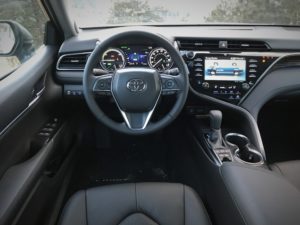
Space-wise, there are no complaints from the driver’s seat and rear passengers will find a comfortable seating position though rear legroom is notably less than that of the roomy Accord. Trunk cargo volume is down slightly compared to the previous generation Camry but the area is still very large and accessible. Toyota further maximizes available space through a compact strut linkage for the trunk lid and folding seat backs, which are made possible via relocating the battery pack to under the rear seats.
Power and Efficiency
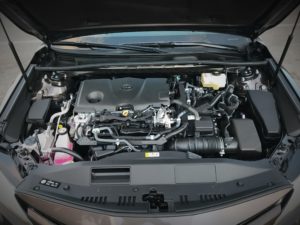
The Camry Hybrid’s 2.5-liter 4-cylinder engine is paired to a continuously variable transmission while an 88-kw electric motor and 1.6-kwh battery, provides additional umph and can solely power the car on its own for about a mile. Total peak power figures are just over 200 hp though the numbers don’t tell the whole story. In the real world, the electric motor’s immediate response and linear power curve works seamlessly with the engine and CVT for a refreshingly calm experience. Once speed picks up though, the engine handles more of the workload. On long mountain highway climbs, the CVT holds the engine at the optimal speed though at mid to high RPM, the sound gets a bit tiring. The entire operation is very smooth and there is little vibration transmitted into the cabin, even on startup.
An EV Mode brings out the Camry’s maximum EV potential however, a delicate touch on the go pedal and ideal operating conditions are necessary. Try to engage EV Mode when the car isn’t ready and the Camry will scold you with a beep and a message – not now you fool! The Normal driving mode is a good balance for everyday driving anyhow.
The CVT does permit “downshifting” to avoid burning up the brakes on extended steep descents though the Camry overrides ratio selections during during acceleration to provide the requested power.
During my week with the Camry, I managed 42 mpg which is slightly below the EPA combined estimate of 46 mpg. While fully acknowledging its off the line power is fun to exploit, I honestly expected a higher result. The Camry’s large power meter is a constant (and large) indicator of driving efficiency and I was impressed by how often the Camry operated in electric-only so those may have mislead my expectations. Regardless, the Hybrid powertrain is an impressive feat of engineering. It adds performance, efficiency, and operates seamlessly in all conditions.
Ride and Drive
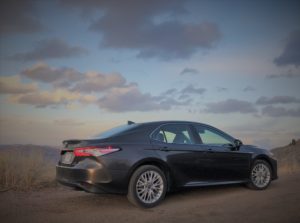
Toyota continues to offer an SE and XSE trims for the more performance-minded customer while the this XLE trim is designed for greater ride comfort. It isn’t going to inspire daydreams of carving through mountain roads or catching air over hill crests, rather it serves the driver best when slogging through city traffic and gliding over highway stretches. The suspension absorbs road imperfections with little harshness being transmitted through to the driver, though there is a secondary motion over high-speed bumps before the car is settled. The standard electric steering rack keeps the driver relatively isolated while remaining precise enough for accurate placement in a turn. Excellent outward visibility and a quiet interior contribute to a relatively stress free commuting experience.
Final Conclusion:
The Toyota Camry’s reputation for reliability, build quality, and value continue to make it a top pick while the expressive designs of the exterior and interior finally add a bit of flair to its personality.
